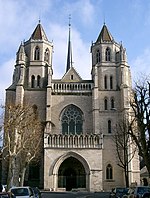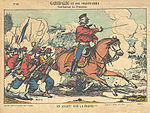Dijon-Ville station
Railway stations in Côte-d'OrRailway stations in France opened in 1849

Dijon-Ville station (French: Gare de Dijon-Ville), sometimes simply Dijon, is a railway station located in Dijon, Côte-d'Or, eastern France. The station was opened in 1849. It is located at the junction of Paris–Marseille, Dijon–Saint-Amour, Dijon–Is-sur-Tille, and Dijon-Vallorbe lines. The train services are operated by SNCF and Lyria.
Excerpt from the Wikipedia article Dijon-Ville station (License: CC BY-SA 3.0, Authors, Images).Dijon-Ville station
Cour de la Gare, Dijon La Gare
Geographical coordinates (GPS) Address Nearby Places Show on map
Geographical coordinates (GPS)
| Latitude | Longitude |
|---|---|
| N 47.32337 ° | E 5.0272080555556 ° |
Address
Cour de la Gare
21000 Dijon, La Gare
Bourgogne-Franche-Comté, France
Open on Google Maps










